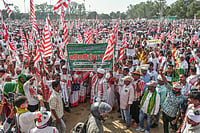In 2021, seventy-two-year-old Vibhuti Bhushan Ghosh started doing jute cultivation on his approximately 13 acres of land. However, massive floods destroyed the yield. In 2022, due to the drought, he had to postpone sowing. This year he has sown jute on 6 acres and maize on 3 acres of land, but he fears that floods will destroy all the crops.
“I am worried about floods. In the event of excess rain, my farm gets completely submerged in water. I incurred huge losses in 2019, 2020 and 2021. Flood water also enters my home. The government should provide a permanent solution to this problem as we don’t get any compensation,” says Ghosh, who lives in Kathal Badi village in Udhwa Block of Sahibganj district in Jharkhand.
In the 2021 floods, Ghosh had suffered losses worth Rs 50,000. He sent a compensation application to the Collector’s Office (CO) and the Block Development Officer (BDO) but has not received a penny yet.
Ghosh informs that most of the villages in the block suffer during floods as flood water from the Ganga River enters their villages and farms.
A large portion of Sahibganj district is flood-prone and the fear of flood water entering villages keeps locals on tenterhooks. During this period, the river flows through this region and eventually merges with the Bay of Bengal. Pakur district, which lies near Sahibganj, also faces the same problem.
Md. Iqbal, a social worker who has been working for the cause of floods in Sahibganj, says that in 2021, both rural and urban areas on Sahibganj got flooded. Many houses and establishments got damaged and acres of land got submerged in flood water.
He feels that the main reason behind recurring floods in Sahibganj is the construction of Farraka Barrage—an artificial barrier to prevent flooding—across the Ganga River. “After the construction of Farraka barrage, both Sahibganj and Pakur face the problem of floods very often. There are four rivers in these two districts that eventually merge with the Ganga,” he says.
Earlier, when the barrage was not constructed, the water used to pass through the plains. However, now, due to the barrage, the water stops. This accumulated water does not get a proper outlet. This leads to a flood-like situation. “Also, the rivers drain a lot of silt in the Ganga. This is lowering the depth of the river resulting in reduced flow. The reason the river gets flooded year after year.”
According to Iqbal, in 300 villages in different blocks in Sahibganj, Rajmahal, Barharwa and Udhwa, almost 90,000 hectares of grains have been destroyed. For people of this region, cultivation is a risky venture, he says.
There are 24 districts in the state. In 2022, 226 blocks of 22 districts had been declared as drought-hit. In the last two years, the farmers had to suffer on account of both floods and droughts. Even normal rainfall may lead to a flood-like situation. If the MET department is to be believed, there is a possibility of normal rainfall.
Asgar Alam, 64, a resident of Abdulhapur village in Barharwa block, is worried. In 2021, a few houses, including his, collapsed due to floods and the fields were submerged in water for long. The villages on both sides of the Gumani River were marooned for a week. “The district administration is not doing much. We incur severe losses and don’t get any compensation.”
The worst affected blocks of Pakur district are Pakur and Maheshpur. Gopi Soren, the district President of Akhil Bhartiya Kissan Sabha, believes crops in an area of 40,000 hectares get destroyed due to these floods.
Describing the geographical reason behind flooding, Soren says: “In the North-South direction is the Bansloi River. If there is heavy rainfall in the hilly areas, the probability of floods increases. The Farraka Barrage stops the flow of the water leading to overflowing. The 2021 floods had adversely impacted ten thousand farmers of Pakur.”
He informs that heavy rain on July 3 led to flooding in the Bansloi River. For two consecutive days, people were terrified that water might enter their homes and fields.
In all the villages, there is a common factor—people don’t get any compensation. Ramniwas Yadav, District Collector of Sahibganj, says that farmers who approach us get compensated as per the disaster management department norms.
“Those who are complaining may not have registered their complaints or the officer in charge may have skipped some of the names. There is a dearth of officers. The amount of compensation is negligible as compared to the thousands of reports we receive.”
As per the rules of disaster management, only 15 per cent of the grains destroyed would be compensated for. If a farmer has incurred losses worth Rs 10,000, he would get a compensation of Rs 1,500. “This amount is also less because farmers who have opted for insurance, receive compensation through the Pradhan Mantri Fasal Bima Yojana. I think the scheme is not operational here.”
According to district administration, almost 50,000 people are adversely affected by these floods and there is no solution to this problem as Sahibganj is situated on a river land. They have made peace with the fact that they have to live with floods.
At the time of writing this report, the level of the Ganga River was at 22 meters. There will be a flood-like situation as soon it reaches 26 meters. Beyond this level, water will start flowing through sewage and drainage to the urban areas.
According to the district administration, all the affected people have been moved to secure places and are living in camps where all the facilities have been provided. They will move back to their homes once the water level recedes in a week. In the last ten years, almost 2.5 lakh people have been affected.
The locals believe that the arrangements made by district administrations prior to the floods are not enough.
Md. Iqbal is of the view that the government should come up with a proper plan to address the issue of water flow from the Farakka Barrage. Dredging machines should be used to clean the silt and clay from the water to maintain the depth of the Ganga River. Fine sand, clay, or other material carried by running water and deposited as sediment on the western side of the river can be cleaned using dredging machines. This helps in maintaining the flow and depth of the river. However, no such cleaning has happened in the past 15 years.
Though these two districts are badly affected due to floods in Jharkhand, several cities in urban areas are not far behind. The worst affected of all the cities is the capital city of Ranchi. Half an hour of rainfall on July 4 at Ranchi, has led to water clogging at many places. This is a common problem for the people of Ranchi during the rainy season.
Nitish Priyadarshi, an environmentalist, highlights three problems. “Ranchi is a sloping area and has a rocky (undulating) terrain. Secondly, the drainage system of Ranchi is in bad shape. Thirdly, the population and encroachment have increased, he says.
Rains in the hilly areas lead to water logging. As the population increased, the areas where this water would get drained got encroached upon. Houses were constructed in the old areas that were traditionally the areas where water found outlets. “Water searches its old route and if does not does not find one, it enters the houses. People get drowned in ravines is common. Water from the ravines flows onto the roads in the cities. The drains and ravines are not closed which leads to accidents,” he says.
For the past two months, people in Ranchi and some other cities are waiting for municipal elections. Sanjeev Vijayvargiya, the outgoing deputy mayor of Ranchi Municipal Corporation says that in the last three years, due to dangerous drains and ravines in the city, four people lost their lives during rains.
He adds: “In 2020, after getting acknowledgement from the Municipal Corporation we sent a plan to the Urban Development Department for fund allocation. Even after three years, we have not received the funds. Only when we receive the funds, we can repair work on the drains. We forwarded the same application to the PWD department on May 10. Let us see when we will receive the funds.
Translated by Kaveri Mishra



























